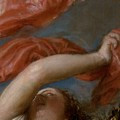Titian’s sensuous interpretation of Classical myths of love, temptation, and punishment
In 1551, Prince Philip of Spain, the future King Philip II, commissioned Titian, the most famous painter in Europe, to produce a group of paintings showing Classical myths primarily taken from the Roman poet Ovid’s ‘Metamorphoses’.
The exhibition reunites all six paintings in the series, from Boston, Madrid, and London, for the first time in over four centuries. Included are ‘Diana and Actaeon’ and ‘Diana and Callisto’; works we own jointly with the National Galleries of Scotland.
Combining Titian’s remarkable talent as both artist and storyteller, the mythological scenes capture moments of high drama; a fatal encounter, the shameful discovery, a hasty abduction. Titian expertly manipulates paint and colour to dazzling effect; capturing luminous flesh, sumptuous fabrics, water, reflection, and atmospheric, almost enchanted, landscapes.
We see gods and goddesses, yet their faces show very human, and very relatable, emotions: guilt, surprise, shame, desperation, and regret.
Titian called these works his ‘poesie’ because he considered them to be visual equivalents of poetry. This is a rare opportunity to enjoy some of the greatest paintings in European art.
Exhibition organised by the National Gallery, the National Galleries of Scotland, the Museo Nacional del Prado, and the Isabella Stewart Gardner Museum, Boston.


